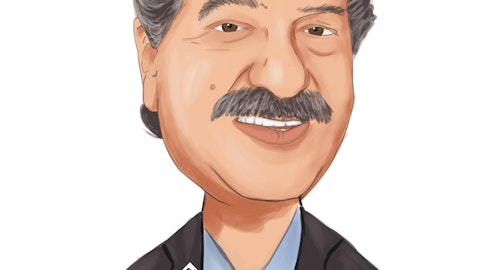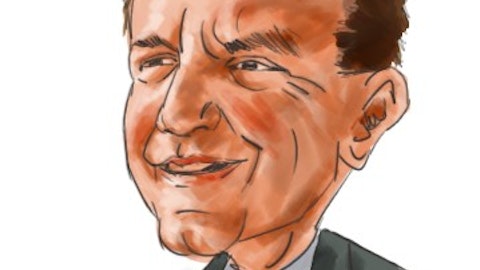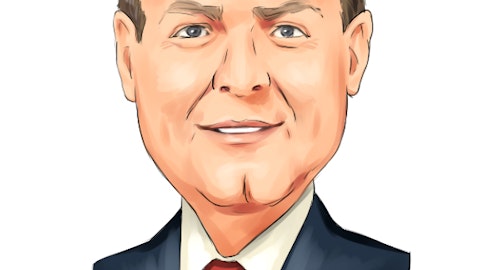Berkshire Hills Bancorp, Inc. (NYSE:BHLB) Q4 2022 Earnings Call Transcript January 26, 2023
Operator: Good morning or good afternoon all and welcome to the Berkshire Hills Bancorp Fourth Quarter 2022 Earnings Conference Call. My name is Adam, and I’ll be your operator for today. I will now hand the floor over to Kevin Conn to begin. So Kevin, please go ahead, when you are ready.
Kevin Conn: Good morning, and thank you for joining Berkshire Bank’s fourth quarter earnings call. My name is Kevin Conn, Investor Relations and Corporate Development Officer. Our news release is available in the Investor Relations section of our website berkshirebank.com and will be furnished to the SEC. Supplemental investor information is provided in an information presentation at our website at ir.berkshirebank.com and we will refer to this in our remarks. Our remarks will include forward-looking statements and actual results could differ materially from those statements. For details, please see our earnings release and most recent SEC reports on Forms 10-K and 10-Q. In addition, certain non-GAAP financial measures will be discussed in this conference call, references to non-GAAP measures are only provided to assist you in understanding our results and performance trends and should not be relied on as financial measures of actual results or future projections.
A comparison and reconciliation to GAAP measures is included in our news release. On the call today, we have Nitin Mhatre, President and Chief Executive Officer of Berkshire Hills Bancorp; Sean Gray, our Chief Operating Officer; Brett Brbovic, our Chief Accounting and Interim CFO; Greg Lindenmuth, our Chief Risk Officer; and Stephen Finocchio, our Treasurer At this time, I will turn the call over to our CEO, Nitin Mhatre. Nitin?
Nitin Mhatre: Thank you, Kevin. Good morning everyone and wishing all of you a Happy New Year. I’ll begin my comments on Slide 3, where you can see the highlights of the fourth quarter and full-year 2022. Overall, this was another solid quarter, continuing the momentum and capping a strong year with robust improvement across all key financial metrics. Adjusted revenues were up 8% quarter-over-quarter and up 31% year-over-year, driven by a strong net interest income growth. This strong growth in revenues was driven by solid loan growth and improved margins, which more than offset the headwinds in non-interest income. Adjusted expenses were up 3% quarter-over-quarter and 6% year-over-year, resulting in positive operating leverage of 5% quarter-over-quarter and 25% year-over-year.
Resulting adjusted PPNR of $45 million was up 16% quarter-over-quarter and up 112% year-over-year. Adjusted earnings per share of $0.64 was up 2% quarter-over-quarter and up 52% year-over-year. This quarter was the highest quarterly adjusted earnings per share since 2019. Adjusted return on tangible common equity was 9.83% and adjusted return on assets was 100 basis points, both of which are close to the lower end of the BEST program targets we set for mid-2024. On the capital front, our balance sheet continues to remain strong. We ended the quarter with a common equity Tier 1 ratio of 12.4% and a tangible common equity ratio of 8%. We continue to have ample capital to both fund our loan growth and continued stock repurchases. We increased our dividend in the fourth quarter by 50% from $0.12 to $0.18 and we’ll target a prudent dividend payout ratio of 30% to 40% of net income over time.
We returned about $28 million of capital to shareholders this quarter via dividends and stock repurchases and we have authorization for a new $50 million share repurchase program in 2023. As we remain vigilant, our overall asset quality remains strong, charge-offs and provision expense for this quarter increased primarily to absorb additional charge-offs from the same credit that we partially charged-off in the third quarter. This was and remains an isolated credit and does not reflect any broad deterioration in credit. In fact most of leading indicators on credit are remarkably strong and our loan delinquencies and classified assets to risk-based capital are at a 10-year low. Separately, an accelerated through our BEST program launch, we have been actively de-risking the balance sheets for the last few years.
We’ve continued to run-off non-strategic credit books, including indirect auto and aircraft lending, both of which are down 50% year-over-year. At mid-last year, we also de-risked the balance sheet further by announcing the run-off of Firestone an Upstart loan books. Credit in both of these books is tracking ahead of plan and we’ve included data and the appendix page, which details how we have de-risked our loan book over the last several years. While it is an uncertain environment, we feel reasonably good about credit for 2023 based on the leading indicators, proactive credit management, and high quality of new originations in recent years. Brett, will review our credit metrics and provide overall 2023 outlook in more detail in a moment. On the BEST strategy front, we made significant progress in 2022.
We continued optimization of our physical footprint, accelerated our programs to enhance our digital banking capabilities, tracked ahead of BEST Community Comeback program goals, issued a sustainability bond in the second quarter, and along with improvements in our financial performance have significantly improved our ESG ranking, customer experience and employee engagement. We started the BEST plan with a guiding idea to get better before we get bigger. With resumed loan growth, we have now transitioned our guiding idea to getting bigger while getting better. What this means is, we will not sacrifice credit or pricing to grow. We will continue to be focused on organic growth that is differentiated, profitable and responsible. Central to responsible growth is a durable lower cost deposit base.
We are well positioned with very high deposit shares in six out of eight of our MSAs and we are in many relatively less competitive smaller city and rural markets. As part of our BEST strategy, we also changed incentive plans to encourage deposit generation, as well as loan generation. We also have several niche deposit strategies, including our MyBanker program and our digital banking platform enhancements. While it is an uncertain environment, we feel good about our relative deposit volumes and cost in the coming quarters. We continue to add talented frontline bankers to bring new customers and relationships to us. We have also recently hired three seasoned executives to supplement our talented leadership team. David Rosato, who many of you may know, will join us as CFO in early February.
David was in finance team at People’s United for 15 years and served as their CFO for the last nine years. Prior to People’s, Dave was the Treasurer at Webster Bank for eight years. We also replaced two senior executives, who have been planning on retiring. George Bacigalupo, our Head of Commercial Banking; and Georgia Melas, our Chief Credit Officer. We thank them immensely for their many years of service and significant contributions to Berkshire Bank and wish them the very best for their future. Jim Brown, has joined us as our Head of Commercial Banking. Jim successfully ran Commercial Banking at Boston Private where he was instrumental in growing Commercial Banking business from less than $0.5 billion in loans and deposits to over $5 billion in loans and $6 billion in deposits.
He brings over 30 years of commercial Banking experience to Berkshire. Phil Jurgeleit, has joined us as our new Chief Credit Officer reporting to Greg Lindenmuth, our Chief Risk Officer. Phil, also brings over 30 years of banking experience including his last assignment as Senior Vice President of Credit Risk at Santander. We’ve included short bios in an appendix page for each executive. We’re excited to have the seasoned executives joined our leadership team. David, Jim and Phil welcome to the Berkshire team. Slide 4, shows our BEST program North Star chart, which details our progress on five key performance metrics. We’ll are happy to report that we’ve achieved three of our five targets well ahead of plan. We are at the low end of our target range on return on assets at 100 basis points and our fourth quarter PPNR of $45 million annualizes to $180 million also at the low end of our 2024 target range.
We’ve achieved our top quartile ESG score back in 2021 and ended 2022 in the 17 percentile, a steady improvement and solidly in the top quartile. We just a bit under the lower end of our 10% to 12% ROTCE target this quarter at 9.83% and are encouraged by the momentum in this critical performance metrics. As we mentioned on our prior earnings calls, we are working on our Net Promoter Score rating process with JD Power and expect to show improving NPS over time. In summary, we are pleased with our momentum through 2022 and are energized about the momentum that will drive further improvements. As I always do, I would like to thank all of our Berkshire Bank colleagues for their continued hard work and commitment to our vision of becoming a high performing leading socially responsible community bank.
Their commitment to our strategy and dedication to our customers is what is driving our ongoing performance improvement and continued progress. I would also like to thank Brett Brbovic for his 10 years of service at Berkshire and for his leadership of the finance team as the Interim CFO during this transition. With that, I’ll turn the call over to Brett, to discuss our financials in more detail. Brett?
Brett Brbovic: Thank you, Nitin. Slide 5 shows our annual income statement. Please see the appendix for a reconciliation of GAAP and adjusted financials. My comments will be on an adjusted basis and non-GAAP. 2022 revenues were up 9% versus 2021. Net interest income grew 18% due to loan growth, increased asset yields, and modest growth in funding costs. Fee revenues were down about 22% primarily driven by lower SBA gain on sale and lower wealth management fees driven by market declines. We maintained our spending discipline with expenses flat year-over-year and improved our efficiency ratio to about 64%. Adjusted EPS was up 30% and average fully diluted shares declined by 7%. Slide 6 shows our quarterly income statement. Revenue was up 8% quarter-over-quarter and 31% year-over-year as net interest income strength offset a decline in fee revenues.

Photo by Scott Graham on Unsplash
Expenses were up 3% quarter-over-quarter and 6% year-over-year and as Nitin, mentioned we had positive operating leverage on both a year-over-year and quarter-over-quarter basis and our efficiency ratio for the quarter was about 58%. Provision expense for the quarter was $12 million and our credit allowance remained relatively stable at $96 million. I’ll discuss revenues, expenses and credit in more detail in a moment. Slide 7 shows our average earning assets. We had another quarter of broad-based loan growth with a 2% increase in average loans versus the third quarter and a 19% increase in average loans year-over-year. On an end of period basis, loans were up 5% quarter-over-quarter with strength in both commercial real estate and C&I up 5% and 3% respectively.
Mortgage balances continued to grow even in a difficult environment, largely driven by the season loan officers hired over the last several quarters. Loan yields rose 74 basis points versus the third quarter and continued to benefit from the shift in mix from lower yielding investments into higher yielding loans. Slide 8 shows our average liabilities. Average total deposits rose 1% versus the third quarter and declined 2% year-over-year. Our cost of total deposits was at 69 basis points, up 36 basis points from the third quarter. Our total deposit beta for the fourth quarter was 25% and our cumulative total deposit beta is 15%. While we benefited from a strong deposit base in 2022, we do expect deposit cost to increase over the coming quarters and we still expect total deposit betas through the cycle to be in the 30% to 40% range.
Slide 9 shows more detail on our net interest income and margin. Net interest income grew 11% quarter-over-quarter and 47% year-over-year. Our net interest margin was up 36 basis points versus the third quarter and we’re happy to report that our adjusted and reported NIM are essentially the same this quarter at 384 basis points. Turning to Slide 10, we show our fee revenues which were down 7% versus the third quarter. This is primarily due to the timing of tax credit deals which closed late in the quarter and accelerated the full amortization into the current period. This resulted in fee — other fee revenues being down due to $2.4 million of tax credit amortization, this is a contra revenue item related to our tax credit business and is more than offset by the benefit received in our tax credit expense, which lowered our tax rate this quarter to about 14%.
Loan fees were higher on more swap revenues, loan agent fees and a sequential improvement in our SBA gain on sale. On Slide 7, we show our expenses. Expenses are up 3% versus the third quarter and 6% year-over-year. I note that compensation expenses benefited from one less working day in the quarter and a reduction to the acquired executive benefit plan expense. Occupancy and equipment was up seasonally on higher heating and snow removal expenses and we continue to invest in technology and as a result, the expense was higher as we continue to rollout our digital banking platform. Other expenses were up from increased reserve requirements for our unfunded commitment reserve, which is a function of doing more business. Finally, our merger and restructuring costs were a negative $2.6 million, which included a favorable reversal of a prior period expense, as estimated lease termination costs were trued up.
I’ll show — I’ll share more on our expense outlook in a moment. Slide 12 is a summary of our asset quality metrics. As Nitin mentioned, we had $11.7 million of net charge-offs this quarter, largely driven by one middle market loan to a corrugated box manufacturer that was impacted by customer receivable defaults and filed for bankruptcy in the fourth quarter. Including the prior quarter charge-off, we’ve charged-off about 60% of this credit and the remaining exposure of about $7 million is collateralized. We will continue to monitor this credit in 2023. Delinquent and non-performing loans were down 14% versus the third quarter and down 36% on a year-over-year basis. Delinquencies and non-performing loans at 60 basis points of loans are at a 10 year low, while we are monitoring credit closely we are not seeing any broad-based portfolio credit deterioration and are encouraged to that our accruing delinquent loans or early stage delinquencies are down 8% versus the third quarter and 55% on a year-over-year basis.
Slide 13 shows details of our liquidity and capital positions. Our loan-to-deposit ratio was 81% this quarter, below our BEST target of 90%. Our common equity Tier 1 capital ratio ended the quarter at an estimated 12.4%. Our TCE ratio ended the quarter at 8% and included a cumulative OCI bond mark of $176 million on an after-tax basis, an improvement to the third quarter, given a modestly lower rate environment. The bond mark includes a $7 million after tax improvement booked in the fourth quarter. Those bonds will pull to par over time and the marks are not included in regulatory capital ratios. Our tangible book value per share ended the quarter at about $21. I want to be clear that this is a non-GAAP adjustment, but excluding the AOCI mark, the total tangible book value per share would increase by about $4, making it the highest TBV per share historically for Berkshire at about $25.
We provided a GAAP to adjusted TBV reconciliation in the appendix. Our top priority is to deploy capital to support organic growth. Given our continuing excess capital position, we repurchased about 661,000 shares for about $20 million in the fourth quarter. We are biased to opportunistic stock repurchases given our relatively low stock valuation to tangible book value. As Nitin mentioned, we grew our cash dividends by 50% in the fourth quarter to $0.18 per share per quarter and announced a new $50 million stock repurchase authorization. Slide 14 shows our outlook for 2023. We plan to share guidance once a year on our fourth quarter call, unless the operating environment changes meaningfully. As many banks do, we based our outlook on the Moody’s baseline forecast and our outlook is based on Fed funds at 4.75% for most of 2023, which may be conservative and provide modest upside to our net interest income.
We expect average loan growth of 11% to 12% and average deposit growth of 3% to 5%. With a full-year of higher rates in 2023, we expect the net interest income to be up 15% to 16%. Fee revenues are forecast to continue to face headwinds and be down 10% to 12%, but I know that, of that decline most of it is due to tax credit amortization. We are targeting $7 million to $9 million of credit provision expense per quarter, which is largely a function of our expected loan growth. For context, our 10 year average provisions to loans is about 30 to 35 basis points. We expect to maintain positive operating leverage with approximately 4% growth in expenses in 2023 driven by wage inflation, technology investment and higher deposit insurance costs. We believe this expense growth will still differentiate our disciplined expense management versus our peers.
Our tax rate is expected to be above 17% to 19% and we expect to opportunistically execute on the new $50 million share repurchase plan. And with that, I’ll turn it back over to Nitin for further comments. Nitin?
Nitin Mhatre: Thank you, Brett. I’ll close my remarks with comments on the economy and our positioning. We are fortunate to be operating primarily in steady Eddie New England market, which remains on a relatively solid footing. As we talk to our customers, we are seeing a bit more caution, driven by tight labor market, inflation and supply chain concerns, but at the same time, activity levels and corresponding demand is supported by the recovery from the pandemic doldrums. In markets like Syracuse, we’re excited about investments being made through local government and private companies like Micron, that will be investing over $100 billion in creating one of the largest microchips plants in the nation. As I said at the beginning of the call, we are well positioned to navigate through an uncertain environment.
We are focused on responsible and profitable growth and are confident that will get bigger while getting better. And with that, I’ll turn it over to Adam for questions. Adam?
See also 11 Tech Stocks with Low PE Ratio and 12 Best Biofuel Stocks To Buy.
Q&A Session
Follow Beacon Financial Corp (NYSE:BBT)
Follow Beacon Financial Corp (NYSE:BBT)
Receive real-time insider trading and news alerts
Operator: And our first question comes from Billy Young from RBC. Billy, please go ahead. Your line is open.
Billy Young: Good quarter here. First, I guess, can we speak to the drivers of your deposit growth in your outlook. I know you mentioned a little bit of it in your prepared remarks.
Nitin Mhatre: Yes, I would say, broadly speaking, the growth was broad-based. Our interest-bearing deposits relatively remained at the same levels at below 28% to 30%. The growth predominantly came through NAV accounts and money market, and we expect to continue that trend. We do believe that the CDs will probably grow at a faster rate in the coming months and quarters, but beyond that, I think we’re very satisfied with the momentum that we have.
Operator: The next question comes from Mark Fitzgibbon from Piper Sandler. Mark, your line is open. Please go ahead. Mark, your line is open, please ask your question. Let’s go to the next question is from David Bishop from Hovde Group, David, please go ahead. Your line is open.
Nitin Mhatre: Adam, I don’t think, we can hear the questions on the line. It looks like it’s gone silent.
Operator: Me too. Please stand by while we rectify the issue. Apologies for the issue there. We will return to our previous Q&A order. So Mark Fitzgibbon from Piper Sandler. Your line is open. Please go ahead.
Mark Fitzgibbon: Guys, can you hear me okay?
Nitin Mhatre: Yes, we can now.
Mark Fitzgibbon: Okay, super. Good morning. First, I wondering if you could just add any color on that one commercial credit that filed for bankruptcy this quarter. Is that completely charged-off, there is no residual exposure there and maybe what happened that caused the company to end up filing for bankruptcy?
Nitin Mhatre: Yes Mark. Yes, it’s the same credit that we partially charged-off in the third quarter and now have charged-off more in this quarter. So we’ve written it down to its collateralized value at this quarter time. So it’s 40% residual, so that’s about $7-ish million that’s left on the books. And what caused it is, there is a disruption in the business model that this customer is experiencing and it’s linked in some ways to supply chain and some way that’s not, but it’s a fluid situation we’re tracking it. But we’ve been proactive and marking it down based on the facts on the ground.
Mark Fitzgibbon: Okay. Great. And then, Nitin, in terms of those merger restructuring charges, both positive and negative. Are those pretty much behind at this point? Should we expect that to be gone in coming quarters?
Brett Brbovic: Yes, this is Brett. We may see a little bit, but I would expect the majority, the significant piece to be gone right now.
Mark Fitzgibbon: Okay. Super. And then can you help us think about the trajectory of the margin over the next couple of quarters?
Nitin Mhatre: Yes, Mark, I think, we did post 384 as NIM this quarter. For next year on an average basis, we believe that NIM would be modestly higher, we do believe that somewhere in the first half the NIM will peak.
Mark Fitzgibbon: Okay. And then lastly, do you worry about growing loans at a double-digit rate this year in what arguably will be a deteriorating economic environment? I guess how do you get comfortable with doing that putting that much in loan growth?





